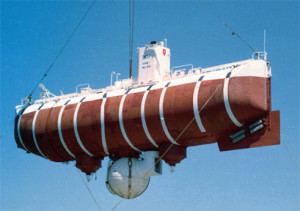What is Bathyscaphe Trieste
A real-life Nautilus, the Bathyscaphe Trieste explored the deepest parts of Earth’s oceans, remaining to this day the only manned vehicle to have reached the bottom of the Mariana Trench in the Pacific.
After passing 9,000 metres (30,000 feet), one of the Plexiglas windows cracked. Over 1,000 atmospheres – a pressure over six tons per square inch – relentlessly bore down upon the Bathyscaphe Trieste. The hull shook violently, threatening to collapse under the mighty strain. If fractured on even a microscopic scale, the weight of the Earth’s deepest ocean would rip the vessel in two, triggering explosive decompression and instantly killing both oceanographer Jacques Piccard and pilot Lieutenant Don Walsh of the US Navy. 23 January 1960, however, was not their day to die. The men had still not reached the bottom of the Mariana Trench’s Challenger Deep; the structure had to hold – there was no plan B.
Descending further into the black void, completely cut off from the outside world – the sonar/hydrophone communications system had packed up hours ago – the Trieste continued to dump iron pellets into its ballast system. After all, you don’t descend vertically nine kilometres (nearly six miles) beneath the surface of the ocean only to quit so close to your goal.
Then finally, out of nowhere and after four hours and 48 minutes within a two-metre (seven-foot) pressurised sphere, Piccard, Walsh and the Trieste touched down. Clouds of diatomaceous ooze (made of the skeletons of dead sea-creatures) diffused from the seabed on contact, filling the surrounding water with a liquidated organic haze.
 Half an hour later, after periodically observing this alien environment with high-powered quartz arc-light lamps – periodically as when activated they caused the water to violently boil – and discovering a multitude of life including a white flatfish, several shrimp and jellyfish, Piccard initiated the Trieste’s ascent. The vessel had held, but at a depth of 10,916 metres (35,814 feet) the temperature of the pressure sphere was dropping continuously (the minimum recorded was just seven degrees Celsius/45 degrees Fahrenheit); if they were not careful, there would be no return. Three hours and 15 minutes later, the Trieste re-emerged into the daylight and human civilization. The vessel and its crew had been to a world only envisioned in fiction and returned with field-changing information.
Half an hour later, after periodically observing this alien environment with high-powered quartz arc-light lamps – periodically as when activated they caused the water to violently boil – and discovering a multitude of life including a white flatfish, several shrimp and jellyfish, Piccard initiated the Trieste’s ascent. The vessel had held, but at a depth of 10,916 metres (35,814 feet) the temperature of the pressure sphere was dropping continuously (the minimum recorded was just seven degrees Celsius/45 degrees Fahrenheit); if they were not careful, there would be no return. Three hours and 15 minutes later, the Trieste re-emerged into the daylight and human civilization. The vessel and its crew had been to a world only envisioned in fiction and returned with field-changing information.
Key to the data gathered was establishing the existence of life at the bottom of Earth’s deepest ocean. This revealed that not only were there creatures impervious to extreme atmospheric pressures, but also that water at this depth wasn’t stagnant. This was a clear indication that ocean currents even penetrated these extreme depths, so they should not be used as a dumping ground for radioactive waste. Unfortunately, despite this first-hand evidence, dumping of this kind still continues throughout large parts of the world to this day.
Today the legacy of the Trieste is being built upon, with numerous programmes currently underway focused on designing new vehicles to return to this uncharted territory. The most high profile of these is Richard Branson’s Virgin Oceanic, which intends to return to the bottom of the Mariana Trench in the latter part of this year.
